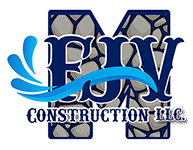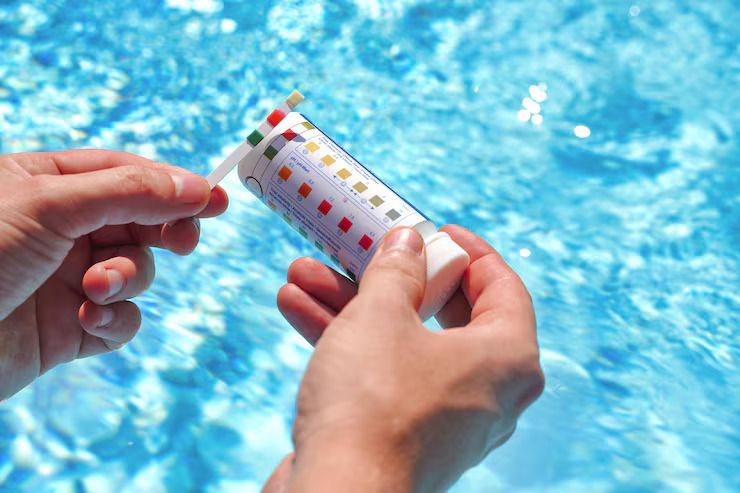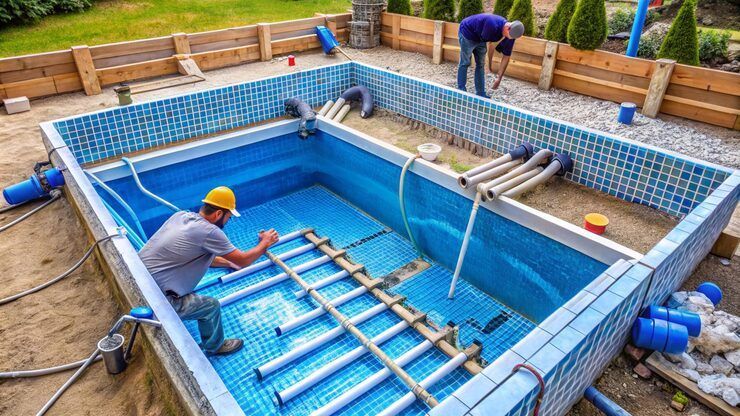Small Backyard? Maximize Space with an Inground Pool Installation
A small backyard doesn’t have to mean sacrificing comfort or luxury, especially when it comes to adding a pool and spa. With the right planning, even compact outdoor spaces can be transformed into private retreats through smart inground pool installation. Creative layouts, thoughtful landscaping, and modern features allow homeowners to enjoy all the benefits of a full-sized pool experience without the sprawl.
Here are five ways to make the most of limited space with a
tailored backyard pool installation.
Table of Contents
- Key Takeaways
- 5 Ways to Maximize a Small Backyard with An Inground Pool and Spa
- 1. Build Smart With a Compact Inground Pool
- 2. Choose the Right Pool Material for the Space
- 3. Work With Experienced Inground Pool Contractors
- 4. Get Creative With Inground Pool Design Ideas
- 5. Prep the Backyard for Smooth Installation
- How to Plan the Ideal Pool Shape for a Small Yard
- Pool Liner vs. Concrete Pool: Which One Works Best in Small Backyards?
- How to Maintain a Pool in a Smaller Yard
- Frequently Asked Questions (FAQs)
- Transform Your Backyard Today with FJV Construction!
Key Takeaways
✔ A small backyard can still accommodate a stylish and functional inground pool installation with the right design.
✔ Compact pools like plunge or cocktail styles maximize space without sacrificing comfort.
✔ Choosing between a pool liner vs a concrete pool depends on budget, design needs, and long-term maintenance goals.
✔ Experienced inground pool contractors help navigate space limitations, zoning rules, and custom features.
✔ Smart excavation for pool installation planning prevents damage and ensures smooth construction in tight areas.
✔ Regular upkeep, compact equipment, and good water balance are key for maintaining small pools efficiently.
✔ Thoughtful backyard pool installation adds value, relaxation, and year-round enjoyment, even in the smallest outdoor spaces.
5 Ways to Maximize a Small Backyard with An Inground Pool and Spa
1. Build Smart With a Compact Inground Pool
Small backyards benefit from scaled-down pools that make the most of every square foot. Instead of going big, a compact inground pool installation focuses on quality, not size. With clever design, it’s possible to fit a stylish pool and spa combo into a tight footprint.
How to Ensure a Smaller Pool Still Delivers Full-Size Enjoyment
- Keep the Layout Tight and Purposeful:
A plunge pool or cocktail pool works well in limited space because it cools, relaxes, and fits neatly against a fence or home wall. These designs often include bench seating or integrated steps, saving room while adding function.
- Combine Pool and Spa in One Structure:
Many inground pool contractors offer dual-purpose models that include a small swim area with built-in spa jets. This hybrid setup delivers the luxury of two features without doubling the space or cost.
- Use Geometric Shapes for Clean Lines: Square and rectangular pools create a streamlined look that maximizes usable space. These shapes also simplify the excavation for pool installation, reducing labor and allowing better alignment with patios or decks.
2. Choose the Right Pool Material for the Space
In a small yard, the type of pool matters just as much as the shape and size. Homeowners often choose between a pool liner vs concrete pool, each offering specific advantages for compact spaces. Selecting the right material ensures a smooth inground pool installation that stays within budget and complements the backyard layout.
How Material Choice Impacts Pool Longevity and Function
- Vinyl Liners Offer Flexibility and Speed: A liner pool is ideal when time and cost are priorities. It installs faster than concrete and adapts more easily to unusual shapes, which is helpful during a tight-space backyard pool installation.
Concrete Pools Provide Long-Term Durability: While concrete takes longer to install, it lasts for decades and allows for full customization. Homeowners with detailed inground pool design ideas can shape every curve, corner, and depth to match their space exactly.
Material Affects Future Maintenance Needs: A pool liner vs a concrete pool requires different upkeep. Vinyl liners may need replacement every 8–10 years, while concrete can be resurfaced after much longer, making maintenance planning part of the overall design discussion.
3. Work With Experienced Inground Pool Contractors
Limited space calls for experience and problem-solving. Skilled inground pool contractors help navigate property lines, zoning codes, and design limitations. Their guidance makes a big difference when space is tight and every detail matters.
How Pool Contractors Make Small Spaces Work
- Understands Local Setback Rules:
In dense neighborhoods, there’s often little room between fences, patios, and the house. Contractors ensure the backyard pool installation meets codes without sacrificing style or size.
- Handles Complex Excavation Logistics:
With less space for equipment access,
precise excavation for pool installation becomes critical. Professional crews use mini-excavators or hand-dig methods when needed to minimize impact and disruption.
- Recommends Layouts That Feel Larger: Experienced inground pool contractors can visually open up a small space using depth changes, lighting, and creative edges. These touches make compact pools feel more expansive and luxurious.
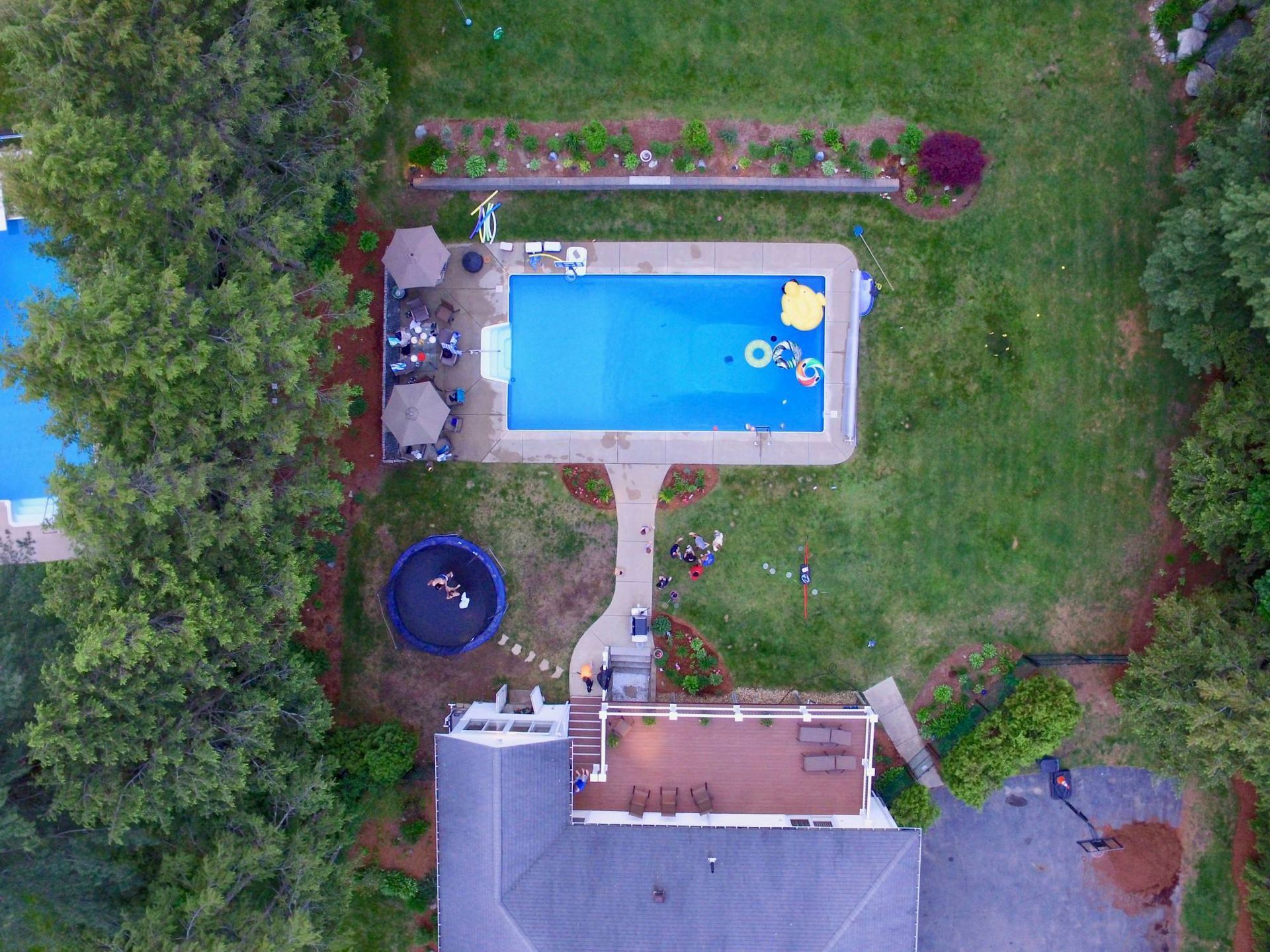
4. Get Creative With Inground Pool Design Ideas
Design can transform even the smallest backyard into a high-end escape. Strategic features and thoughtful layouts unlock a wide range of possibilities, proving that great things come in small packages. The right inground pool design ideas enhance function, beauty, and relaxation—all without crowding the yard.
How to Maximize Limited Space with Creative Design
- Incorporate Multi-Use Features:
Tanning ledges that double as kid splash zones or spa corners that blend into the pool keep the space efficient. These hybrid features allow more enjoyment without needing extra square footage.
- Opt for Built-In Seating or Ledges:
Instead of separate furniture, benches molded into the pool interior save room and streamline the design. They’re especially popular in inground pool installation for compact lots.
- Use Visual Tricks to Expand the Look:
Clean lines, light-colored finishes, and smart lighting create the illusion of more space. Designers often apply these techniques in backyard pool installation projects to enhance ambiance and open up the area visually.
5. Prep the Backyard for Smooth Installation
Before the first shovel hits the ground, the site must be ready. Smart preparation reduces delays, prevents surprises, and ensures the inground pool installation stays on schedule. This is where planning meets execution, and it begins with proper excavation for pool installation.
How to Prepare the Site for Success
- Assess the Terrain and Access Points:
Small backyards often have limited entry paths for equipment. Contractors inspect gate widths, slopes, and landscaping early to plan the most efficient excavation for pool installation.
- Secure Permits and Follow Code: Every town has rules about setbacks, fencing, and pool barriers. Reliable inground pool contractors handle paperwork and ensure compliance so that construction goes smoothly and legally.
- Protect Existing Structures and Landscaping:
In compact spaces, pools sit close to patios, gardens, or sheds. Careful backyard pool installation avoids damage and may include temporary barriers or landscape removal for safe equipment movement.
How to Plan the Ideal Pool Shape for a Small Yard
The swimming pool construction industry has seen steady growth, with revenue estimated to reach $16.5 billion in 2025. This reflects an increasing demand for custom pool solutions, even in smaller residential spaces.
Choosing the right pool shape can make all the difference in a tight backyard. With help from experienced inground pool contractors, a smart layout will enhance function, style, and flow, even in compact spaces.
1. Measure the Usable Area First
Before picking a shape, it’s essential to know exactly how much space is available. This means measuring not just the total yard but also the setbacks, utility lines, and existing landscaping. Accurate measurements help contractors suggest realistic inground pool design ideas that won’t overwhelm the space.
2. Consider How the Pool Will Be Used
The shape should reflect how the pool will function—lap swimming, lounging, or kid-friendly play. A rectangular pool might suit fitness-focused owners, while a freeform design could better match relaxed social use. Inground pool installation should fit the lifestyle, not just the yard.
3. Opt for Shapes That Follow Property Lines
Angular shapes like rectangles or L-shapes are ideal when working close to fences, patios, or buildings. These clean lines often simplify excavation for pool installation and make it easier to navigate permit restrictions. Contractors often recommend these shapes to create seamless transitions between pool and yard.
4. Use Rounded Shapes to Soften Tight Spaces
In narrow or unusually shaped backyards, curves can soften the look and avoid a boxy feel. Kidney or oval pools offer visual movement and flow, helping the area feel more open. A curved backyard pool installation also creates natural room for plant beds or seating nooks.
5. Match Shape to Pool Material
The choice between a pool liner vs concrete pool will influence how flexible the shape can be. Vinyl liner pools tend to work best with simpler shapes, while concrete offers nearly unlimited options for custom curves or angles. Working with seasoned inground pool contractors helps match design goals with practical build methods.
6. Account for Surrounding Features and Access
The best pool shape works in harmony with existing elements like patios, doors, and shade structures. There also needs to be enough access for inground pool installation equipment and maintenance paths post-install. Professionals help plan the layout so the pool complements the yard.
Pool Liner vs. Concrete Pool: Which One Works Best in Small Backyards?
Choosing the right material is a key part of a successful inground pool installation, especially when working with limited space. Both vinyl liners and concrete pools offer unique advantages depending on layout, budget, and maintenance preferences. Here’s a clear comparison to help guide small backyard pool installation decisions:
| Aspect | Vinyl Pool Liner | Concrete Pool |
|---|---|---|
| Installation Time | Vinyl liner pools install quickly—often within a few weeks. This makes them ideal for small spaces where fast excavation for pool installation limits backyard disruption. | Concrete pools require a longer build timeline due to custom shaping and curing. Inground pool contractors usually schedule several weeks for proper finishing. |
| Design Flexibility | Vinyl liner pools come in standard shapes like rectangles and ovals, which work well in basic layouts. While limited in shape, they still support a variety of inground pool design ideas | Concrete pools offer full design freedom, from freeform curves to built-in features. They are often the go-to for custom-shaped backyard pool installation. |
| Durability and Longevity | A vinyl liner typically lasts 8 to 10 years before replacement is needed. It’s a solid choice for short- to mid-term pool ownership. | Concrete pools can last several decades with resurfacing every 10–15 years. For long-term investment, they are the more durable inground pool installation option. |
| Maintenance Needs | Vinyl liners are easier to clean and resist algae buildup due to their smooth surface. However, they can tear or puncture more easily. | Concrete pools require more brushing and chemical balancing. Their porous surface can develop algae if not properly maintained, especially in shaded small backyards. |
| Cost Considerations | Vinyl is more budget-friendly upfront and ideal for homeowners managing a tight project budget. It offers value without sacrificing function in a small backyard pool installation. | Concrete is a higher-cost investment but delivers lasting appeal and property value. Many inground pool contractors suggest it for those seeking a long-term, customized pool experience. |
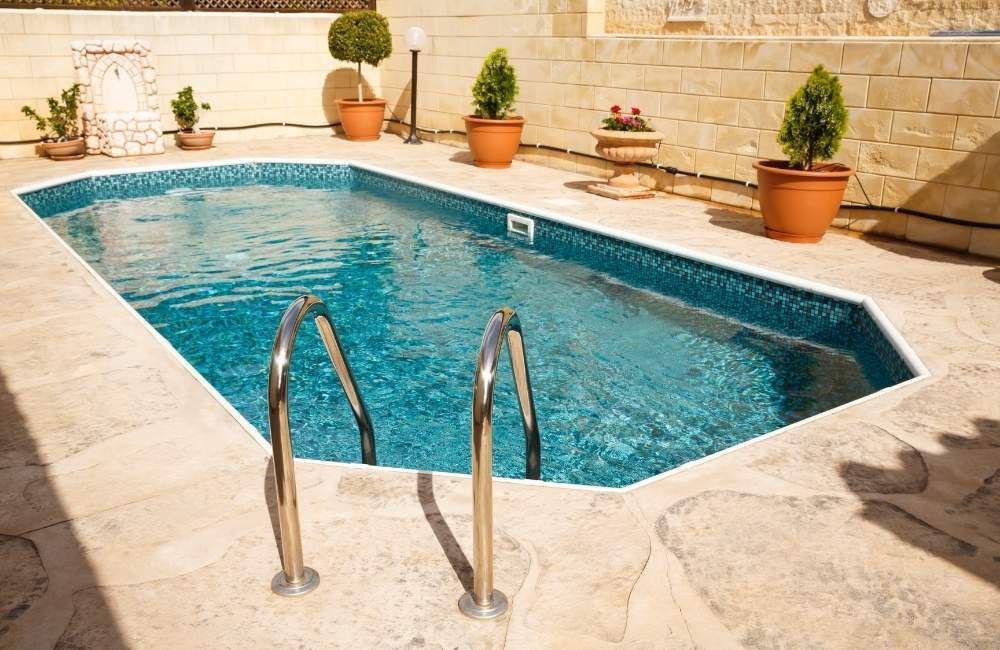
How to Maintain a Pool in a Smaller Yard
With a pool's return on investment (ROI) ranging from 5% to 56%, proper maintenance becomes even more important to protect that investment over time. Keeping a pool in great shape requires consistent care, but small yards come with unique challenges. Limited space for equipment, tighter access, and less room for storage mean maintenance must be efficient and well-planned.
1. Install Space-Saving Equipment
In small backyards, bulky pool pumps and filters can crowd the landscape. Opting for compact or multi-functional equipment keeps things tidy while supporting proper circulation. Many inground pool contractors recommend systems that combine filtration and chlorination in a single unit to reduce clutter.
2. Use Automatic Cleaners Designed for Tight Areas
Robotic pool cleaners are a smart investment for limited spaces. These small machines can navigate compact inground pool installation layouts with ease, keeping floors and walls clean without manual effort. They’re especially helpful for pools with narrow ledges or curved designs.
3. Stick to a Weekly Cleaning Routine
Smaller pools might seem easier to maintain, but debris builds up quickly due to proximity to trees, fences, and patios. A consistent weekly cleaning schedule helps avoid algae growth and keeps the water clear. Regardless of whether it's a pool liner vs. concrete pool, staying ahead of dirt extends surface life.
4. Cover the Pool When Not in Use
A well-fitted pool cover helps minimize evaporation, keeps out leaves, and reduces chemical loss. This is especially helpful in small yards where nearby plants and wind can introduce extra debris. For inground pool installation in tight areas, a retractable or custom-fit cover is worth the investment.
5. Maintain Proper Water Balance
Testing and adjusting chemical levels regularly prevents algae, bacteria, and liner damage. Compact backyard pool installation setups can have more concentrated chemical reactions due to lower water volume, so balance is even more critical. Professional inground pool contractors often offer maintenance plans that include water testing and treatment.
6. Protect Surrounding Landscaping
Grass, mulch, and planters close to the pool can introduce dirt and organic matter. Choosing low-shedding plants and using barriers or edging helps keep the area clean. This is especially important after excavation for pool installation, when soil disruption can increase debris risk.
Frequently Asked Questions (FAQs)
Can an inground pool be installed in a sloped backyard?
Yes, an inground pool installation can be done on a sloped yard with proper grading or retaining walls. Working with experienced inground pool contractors ensures the slope is safely leveled and drainage is handled correctly. This approach can even enhance the pool’s look by creating multi-level landscaping around the design.
How close can a pool be to the house in a small backyard?
Setback rules vary by location, but most building codes require a few feet of space between the pool and any structures. Skilled inground pool contractors can help navigate these regulations and design a layout that fits tight footprints. A smart backyard pool installation can still feel spacious with proper spacing and design tricks.
Can a spa be added later to an existing inground pool?
Yes, a spa can be added to an existing inground pool installation, but it requires additional plumbing and electrical work. It’s usually more cost-effective to include a spa during the original backyard pool installation. Planning allows both features to blend better in design and function.
Is it possible to heat a small inground pool efficiently?
Small inground pool installation projects heat up faster due to their reduced volume. Options like solar covers or compact heat pumps work well in smaller spaces. Inground pool contractors can recommend energy-efficient systems that suit the yard size and local climate.
What’s the best time of year to start excavation for pool installation?
Spring and early fall are popular times for excavation for pool installation due to moderate weather and soil conditions. Starting early in the year allows time for permitting and design adjustments. Discussing timelines with inground pool contractors helps avoid delays and ensures a smoother project from start to finish.
Transform Your Backyard Today with FJV Construction!
Ready to turn a small backyard into something incredible? FJV Construction in Danbury, CT, specializes in custom inground pool installation that fits your space, style, and budget. Our team of experienced inground pool contractors works closely with homeowners to design pools that blend seamlessly into tight yards without sacrificing comfort or function. From creative layouts to expert excavation for pool installation, we deliver reliable craftsmanship every step of the way.
Reach out today and bring that dream pool and spa combo to life!
